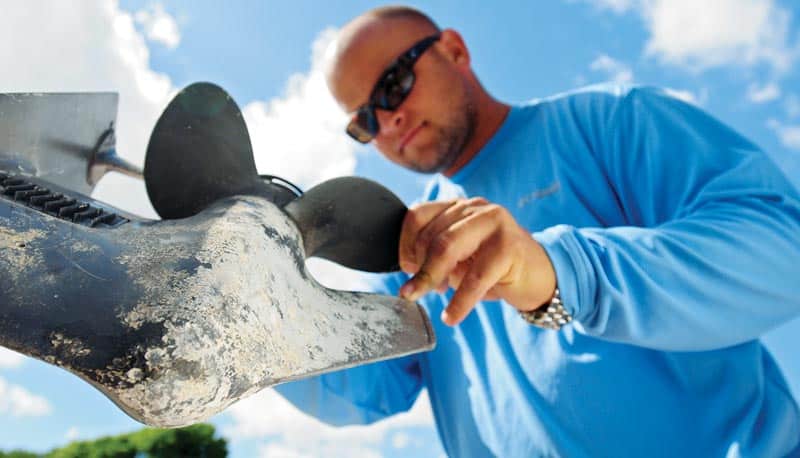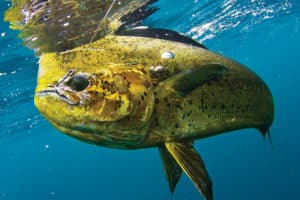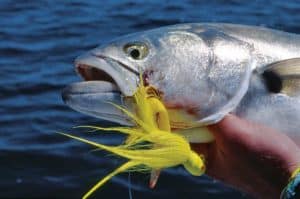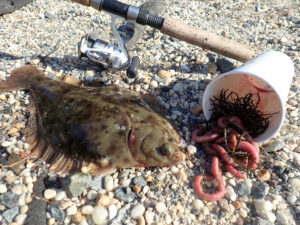
Rust never sleeps, especially when it comes to metal components on a saltwater fishing boat. Yet, you can keep salt-borne corrosion at bay. Start with the correct metals.
Marine Metals
For rails and T-top frames, there are two choices: aluminum or stainless steel in alloys developed for marine applications such as 5086 aluminum and 316 stainless steel. For through-hull fittings below the waterline, use marine-grade bronze. Avoid brass or aluminum for fittings underwater — they just don’t have enough corrosion resistance.
All bolts, screws, washers and nuts should be marine stainless, but take care to isolate fasteners from dissimilar metals such as aluminum. If direct contact takes place in a salty, moist environment, the less “noble” of the two metals (in this case, aluminum) tends to corrode quickly due to galvanic action. Applying a thread lubricant such as Forespar LanoCote (www.forespar.com) creates a barrier between dissimilar metals to keep them from seizing and thwarts galvanic action.
Most marine aluminum carries a corrosion-resistant, cosmetic surface treatment such as shiny anodizing or powder coating, but aluminum is easily scratched. Inside a scratch, salt can gain a foothold and foment corrosion that leads to ugly pitting. However, a system called ShowBoat Custom Coating (www.showboatcustomcoating.com) can bring even heavily corroded aluminum back to like-new appearance and help keep it that way. The two-step process starts with cleaning and polishing the aluminum, and then applying a corrosion-resistant coating called SB-230. It is available in a variety of colors including clear, and it can also be applied to other types of metals such as stainless steel.
While bronze deck hardware (both chromed and nonchromed) was prevalent in years past, it has been replaced by polished marine stainless steel — one of the strongest and most corrosion-resistant marine metals. It’s the top choice for items such as cleats and anchor rollers, as well as fasteners. Yet it will rust, particularly in joints where minute salt crystals can collect and attract moisture, such as where a rail stanchion, cleat or flush-mount rod holder bolts to the deck or gunwale.
To eliminate corrosion, use a marine sealant such as 3M 4200 Fast Cure (www.3m.com) to “bed” stainless hardware. If rust does appear around the edges of the metal, remove the piece, polish out the rust, and reinstall the part with new fasteners and fresh sealant.
Electrical Systems
Your boat’s electrical systems are also subject to corrosion, which can lead to failure of pumps, electronics, lights and even the engine. In a worst-case scenario, it can cause a fire when a corroded wire overheats.
To help prevent corrosion, use only electrical components designed for marine applications. For example, marine-grade wire and cable from companies such as Ancor (www.marinco.com) feature oil- and water-resistant insulation over multistrand copper wire with a special tin coating.
When making connections, after stripping back the insulation, coat the bare wire with dielectric grease, and then use marine-grade crimp connectors and terminals with heat-shrink nylon sleeves. Also, enclose all connections with heat-shrink tubing.
Make sure all electrical switches, distribution panels, bus bars and fuse holders are also made for marine use, such as those offered by Blue Sea Systems (www.bluesea.com), and place them in areas that are shielded from spray and excessive moisture.
Engines and Drives
To fight corrosion in the water passages in a raw-water-cooled engine or the core of a heat exchanger, rinse the cooling system with fresh water after every trip. Most engines have a special port that connects to a garden hose to flush the system, as well as the lower unit of an outboard or stern-drive, and you do not need to start the engine to do this.
Regularly inspect the sacrificial zinc anodes on your engine and drive system to make sure they’re taking the brunt of the corrosive effects of salt water. Replace them once they erode to less than 70 percent of their original size.
If you keep an outboard boat in the water, tilt the engine up as far as possible to minimize corrosion to the lower unit. A stern-drive won’t tilt out of the water, so having properly bonded sacrificial zinc anodes is even more critical.
If your boat is on a trailer and you have an outboard or stern-drive, you can also use an earmuff-style flushing device that attaches to the lower unit. This lets you run the engine using a garden hose for cooling water. There are also garden-hose attachments that allow you to infuse the system with a salt-dissolving solution such as Salt‑Away (www.saltawayproducts.com).
**
Wash and Lube**
Keeping all surfaces free of brine crust goes a long way toward slowing down corrosion. Wash your boat with mild soap and water as soon as possible after each trip, and wax metal components twice a year with a product such as Star brite Premium Marine Polish with PTEF (www.starbrite.com).
Keep metals below deck and under the outboard cowling clean and free of salt, particularly when it comes to engine blocks, pumps, seacocks and electrical components such as battery terminals. You can spray lightly and wipe off salt buildup with a solution such as Salt‑Away.
If corrosion appears on an engine block or pump housing, for example, clean it up with a wire brush, then apply a coat of primer and matching paint to help keep the rust from returning.
Finally, spray below-deck fixtures, electrical terminals and outboard parts regularly with a rust inhibitor such as Corrosion Block (www.nocorrosion.com).
Rust might never sleep. But taking steps to slow it down might allow you to rest a bit easier.








